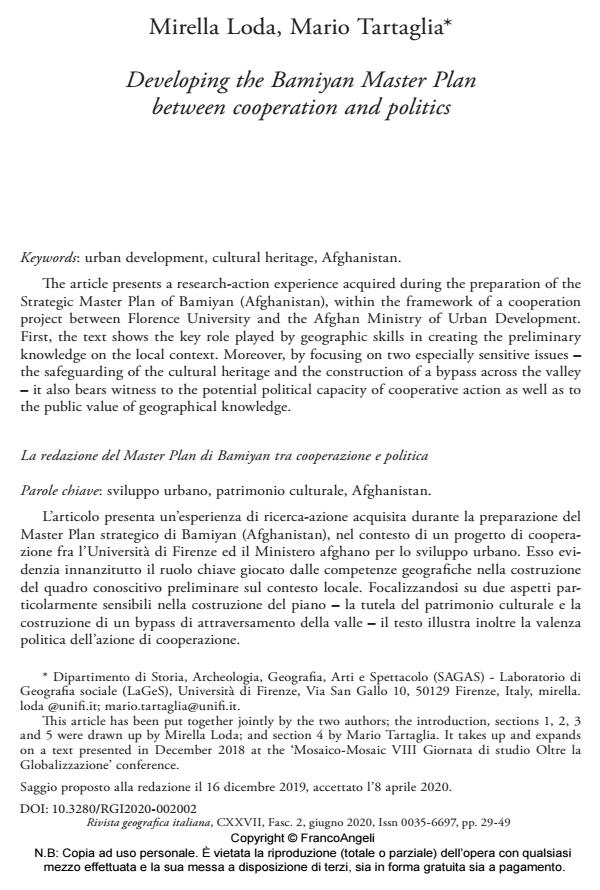Developing the Bamiyan Master Plan between cooperation and politics
Titolo Rivista RIVISTA GEOGRAFICA ITALIANA
Autori/Curatori Mirella Loda, Mario Tartaglia
Anno di pubblicazione 2020 Fascicolo 2020/2
Lingua Inglese Numero pagine 21 P. 29-49 Dimensione file 772 KB
DOI 10.3280/RGI2020-002002
Il DOI è il codice a barre della proprietà intellettuale: per saperne di più
clicca qui
Qui sotto puoi vedere in anteprima la prima pagina di questo articolo.
Se questo articolo ti interessa, lo puoi acquistare (e scaricare in formato pdf) seguendo le facili indicazioni per acquistare il download credit. Acquista Download Credits per scaricare questo Articolo in formato PDF

FrancoAngeli è membro della Publishers International Linking Association, Inc (PILA)associazione indipendente e non profit per facilitare (attraverso i servizi tecnologici implementati da CrossRef.org) l’accesso degli studiosi ai contenuti digitali nelle pubblicazioni professionali e scientifiche
The article presents a research-action experience acquired during the preparation of the Strategic Master Plan of Bamiyan (Afghanistan), within the framework of a cooperation project between Florence University and the Afghan Ministry of Urban Development. First, the text shows the key role played by geographic skills in creating the preliminary knowledge on the local context. Moreover, by focusing on two especially sensitive issues - the safeguarding of the cultural heritage and the construction of a bypass across the valley - it also bears witness to the potential political capacity of cooperative action as well as to the public value of geographical knowledge.
L’articolo presenta un’esperienza di ricerca-azione acquisita durante la preparazione del Master Plan strategico di Bamiyan (Afghanistan), nel contesto di un progetto di cooperazione fra l’Universita di Firenze ed il Ministero afghano per lo sviluppo urbano. Esso evidenzia innanzitutto il ruolo chiave giocato dalle competenze geografiche nella costruzione del quadro conoscitivo preliminare sul contesto locale. Focalizzandosi su due aspetti particolarmente sensibili nella costruzione del piano - la tutela del patrimonio culturale e la costruzione di un bypass di attraversamento della valle - il testo illustra inoltre la valenza politica dell’azione di cooperazione.
Parole chiave:Sviluppo urbano, patrimonio culturale, Afghanistan
Mirella Loda, Mario Tartaglia, Developing the Bamiyan Master Plan between cooperation and politics in "RIVISTA GEOGRAFICA ITALIANA" 2/2020, pp 29-49, DOI: 10.3280/RGI2020-002002